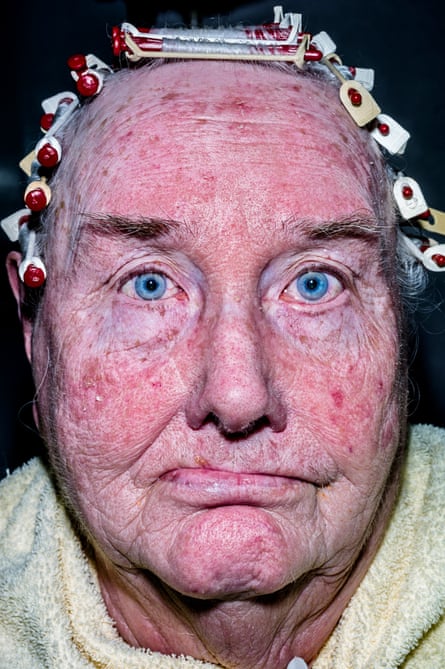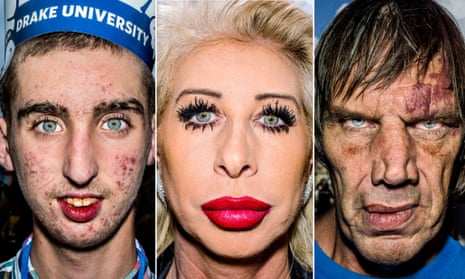Bruce Gilden’s mugshots are exactly that: the result of being mugged by his camera. He once described the way he photographs as “flash in one hand and jumping at people”. On YouTube, you can see him on the streets of New York, striding purposefully through the crowds and suddenly thrusting his camera into the faces of unsuspecting subjects.
It’s a very old-school New York style of photography: tough, confrontational, literally in-your-face and, after 40 years of doing it, he is a master of sorts. You love his photographs or you hate them. He probably doesn’t give a damn either way.
My favourite book by Gilden is Coney Island, one of his first projects, in which he photographed sunbathers, barkers and visitors at the crowded resort. In the photos, eccentricity and ordinariness exist side by side, accentuated by his eye for the grotesque. There is a humanity to these early images, even if they often elevate the eccentric over the everyday.
“My style evolved because I liked being among the common man,” he once said. “I like characters. I always have. When I was five, I liked the ugliest wrestler, so it was easy for me to pick what I wanted to photograph.”
Gilden’s new book is called Face. Even by his standards, it’s extreme. Here, the street is not visible at all. The frames are entirely filled by unforgiving portraits of people who have been battered and bruised by life itself: by being poor, disenfranchised and, in some instances, by a retreat into alcoholism or addiction. And, unusually, he gained permission from all his subjects.
Face is problematic however you look at it: a catalogue of human grotesques that, asserts Chris Klatell in a short essay in the book, is both “a political gesture”, to acknowledge the disenfranchised, and a sustained self-portrait.

“Here are Bruce Gilden’s people, his family,” writes Klatell. “He shares their teeth, their stubble, their scrapes, their blemishes, their fear of death. In the women’s scowls, in their sternly ambiguous glance, he sees his own mother’s face before she killed herself.”
For all that, Face remains a relentless – and relentlessly cruel – cataloguing of the kind of ugliness to which Gilden was drawn when he watched wrestling bouts as a child. Here, the blemishes, bad teeth, the stubble and the scrapes – as well as the pimples, wounds, wrinkles, and bulbous veined noses – are rendered even more extreme by the closeness of the camera and the unremitting light of the flash.
Gilden may be shoving these broken faces in our faces to confront us with what we usually choose to look away from. But his style seems to work against any intention to humanise his subjects. First and foremost, I feel uncomfortable as a viewer – not because of the poverty or abuse etched on to the landscapes of these faces, but because their perceived ugliness is paraded as a kind of latter-day freak show.
Klatell also asserts that Face is “Gilden’s Facebook”, a retort to the “posed, mechanically lit idiom of social media”. In that context, Face becomes “a counter network, a shadow network, a network of portraits one never sees on Facebook”. But given the casual cruelty of the internet age, the portraits could be endlessly disseminated across social media, decontextualised even further and no doubt mocked.
That, of course, is Gilden’s fault. But whatever his intentions, we are complicit, as viewers – and consumers – of his images. It seems ironic that, having gained permission from his subjects, his results are somehow even more intrusive and, at times, demeaning. Face is undeniably powerful, but the chasm between Gilden’s goal and the end result seems vast.
Face is out now, published by Dewi Lewis.

Comments (…)
Sign in or create your Guardian account to join the discussion